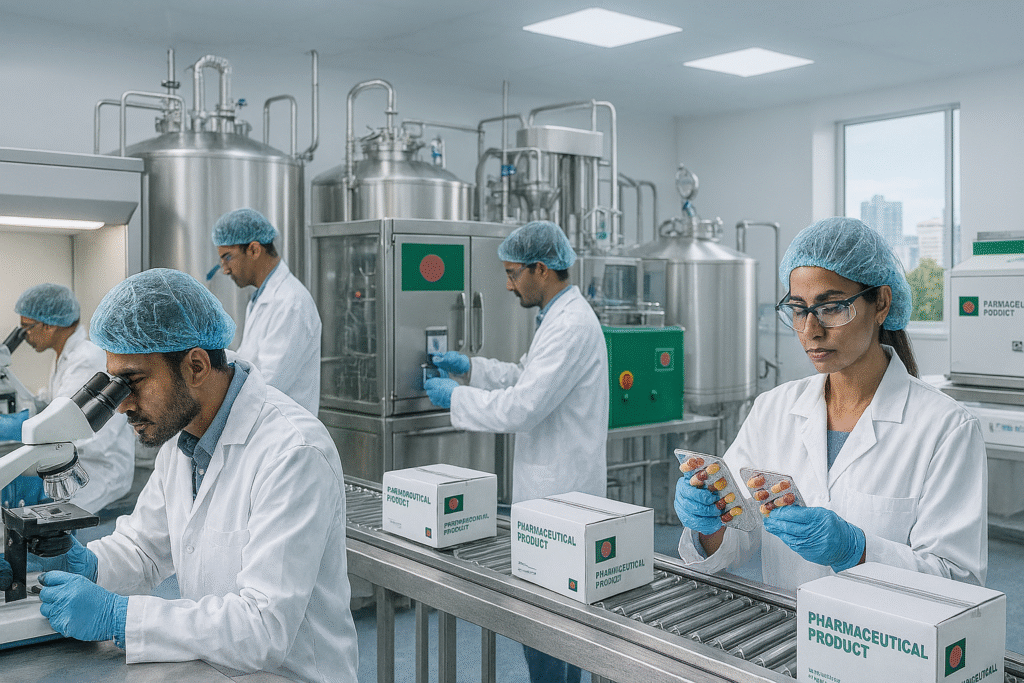Pharmaceutical Industry of Bangladesh: From Domestic Necessity to Global Ambition
The pharmaceutical industry of Bangladesh has undergone a dramatic transformation in recent decades. Once heavily reliant on imports and multinational companies, Bangladesh today manufactures about 98% of its domestic medicine demand and exports to nearly 150 countries.
What started as a local industry to meet basic health needs has blossomed into a globally-relevant sector with ambition, competitive pricing, and emerging research capabilities. As healthcare challenges mount worldwide, Bangladesh’s pharmaceutical sector offers a compelling example of how emerging economies can contribute to global medicine supply chains and affordable healthcare.
Historical Evolution and Industry Overview
The pharmaceutical industry of Bangladesh took root in the 1950s and gained real momentum after independence in 1971. With patent exemptions under the British Patents and Designs Act and later under the World Trade Organization’s TRIPS (Trade-Related Aspects of Intellectual Property Rights) framework, Bangladesh benefitted from lower-cost generic production. Today, there are roughly 257 licensed pharmaceutical factories, of which about 150 actively operate to satisfy nearly all domestic demand. Local firms—such as Square Pharmaceuticals Ltd., Beximco Pharmaceuticals and Incepta Pharmaceuticals—dominate the market, producing some 80% generic drugs while retaining about 10% of the market under multinational companies.
Key Growth Drivers
Rapid Domestic Demand Growth
With a population exceeding 160 million, a rising middle class and growing health awareness, the domestic base for the pharmaceutical industry of Bangladesh continues to expand. The average life expectancy has risen and urbanisation is increasing, both of which drive demand for modern medicines.
Export Expansion and Global Reach
Exports have become a significant facet of the pharmaceutical industry of Bangladesh. In fiscal year 2019-20, exports reached around US $136 million and the country was exporting to 147 countries. Analysts forecast exports will rise substantially in the coming years, signalling Bangladesh’s move from local supplier to global player.
Cost-Competitive Generic Production
The country’s patent exemption privileges enabled low-cost generic drug production, making the pharmaceutical industry of Bangladesh highly cost-competitive. This enables the sector to serve not only domestic markets but also export to other developing countries and even some developed markets, enhancing global relevance.
Global Comparisons: Why Bangladesh Matters
In a global context where pharmaceutical supply chains have been under pressure — due to pandemics, regulatory shifts and rising costs — the pharmaceutical industry of Bangladesh presents an alternative model. While many nations import finished medicines or active pharmaceutical ingredients (APIs), Bangladesh’s ability to produce finished formulations at relatively low cost gives it strategic relevance. For global health programmes, developing countries, and humanitarian agencies, affordable medicines from Bangladesh provide relief and accessibility. Also, the success of the pharmaceutical industry of Bangladesh illustrates how emerging markets can integrate into the global pharma value chain, not just as raw-material providers but as full-spectrum manufacturers.
Major Players and Competitive Landscape
Within Bangladesh, the pharmaceutical industry of Bangladesh is led by firms such as Square (market share ~16 %), Incepta (~10.21 %), Beximco (~8.39 %) and Opsonin (~5.54 %). These firms exemplify how local players have grown from domestic manufacturing to export-oriented enterprises. Square, for instance, has established a manufacturing plant in Kenya to expand its footprint beyond Bangladesh.
Challenges & Future Threats
Despite the impressive growth of the pharmaceutical industry of Bangladesh, key challenges threaten its future trajectory. One major concern is the upcoming loss of patent-exemption benefits under the TRIPS agreement as Bangladesh transitions from the least-developed country (LDC) status. This could raise costs for generic producers or force royalty payments, reducing competitiveness globally. Another issue is the heavy dependence on imported APIs. The pharmaceutical industry of Bangladesh still imports much of its raw material, thereby exposing it to currency and supply-chain risks.
Additionally, the presence of counterfeit and sub-standard medicines poses reputational risk. The domestic market is particularly vulnerable, which can undermine export credibility. Finally, lack of strong research and innovation remains a barrier; the pharmaceutical industry of Bangladesh still lags in patented drug development, limiting its movement into higher-value segments.
Global Implications and Strategic Opportunities
Contributing to Global Health Security
The pharmaceutical industry of Bangladesh can play a pivotal role in global health, especially for low- and middle-income countries. As developed markets face cost-pressures and supply-chain disruptions, Bangladesh could emerge as a reliable supplier of generics, and potentially APIs, bridging gaps in global access to essential medicines.
Exporting Beyond Traditional Markets
While the pharmaceutical industry of Bangladesh currently exports to many developing nations, there is potential to expand into regulated markets in Europe, North America and other high-income regions, provided quality, regulatory compliance and innovation improve. Such expansion would enhance global trade ties and diversify revenue streams.
Strategic Partnerships and Innovation
For the pharmaceutical industry of Bangladesh to achieve global relevance, strategic international collaborations are vital. Partnerships with multinational pharmaceutical companies for technology transfer, joint ventures for research and development, and investment in biotech or vaccine capabilities could elevate Bangladeshi firms into global contenders.
Sustainability and Ethical Healthcare
The global discourse around sustainable healthcare emphasises affordable medicines, ethical manufacturing and safe distribution. The pharmaceutical industry of Bangladesh’s focus on generics aligns with this agenda. Ensuring environmentally responsible production, equitable access and transparency will reinforce Bangladesh’s role in global sustainable health.
Conclusion
The pharmaceutical industry of Bangladesh stands at a unique intersection: strong domestic base, growing export footprint and cost-advantage in generic production. While challenges persist, the sector’s evolution offers valuable lessons for other nations and has real global relevance.
If Bangladesh can navigate patent changes, enhance innovation and strengthen quality systems, the pharmaceutical industry of Bangladesh may not only meet national demand but shape global markets, healthcare access and sustainable medicine supply chains.
